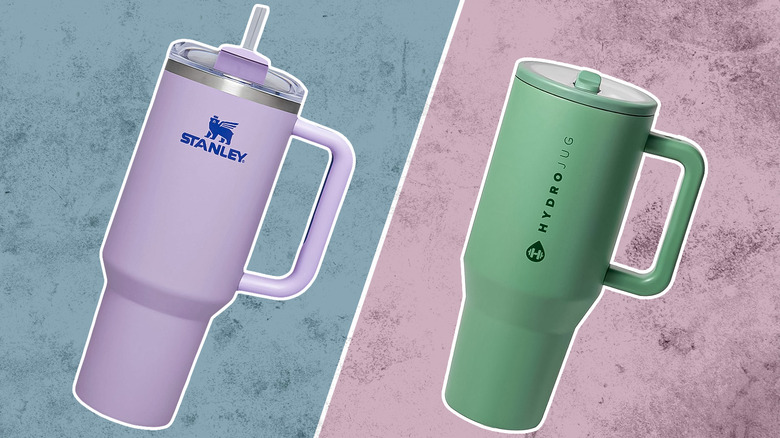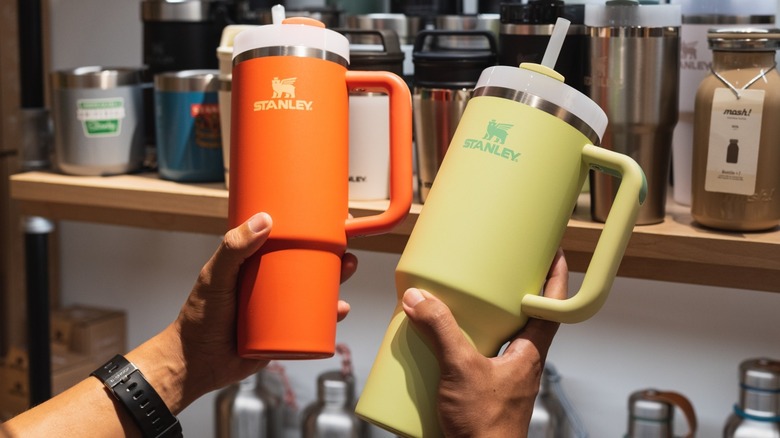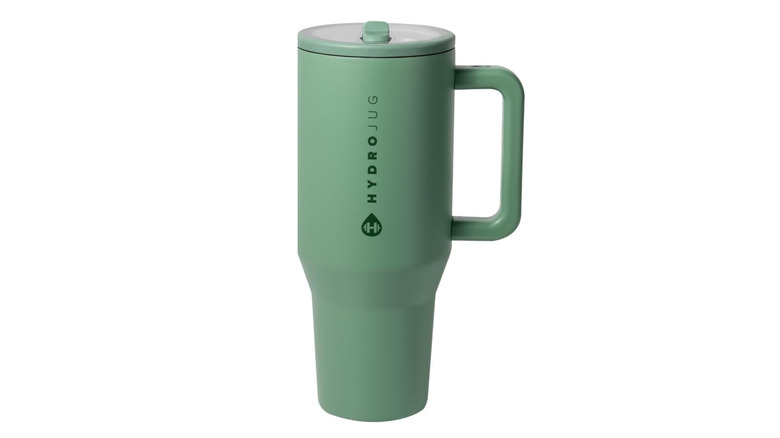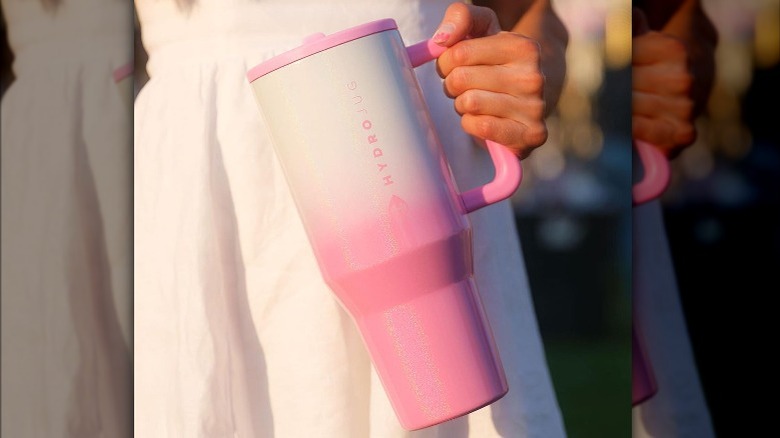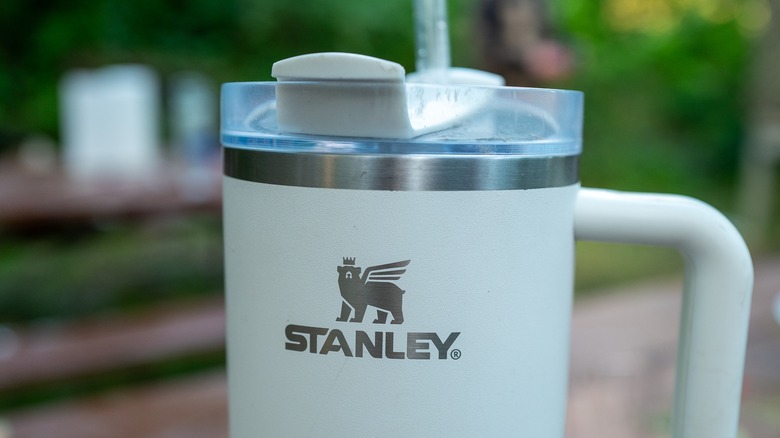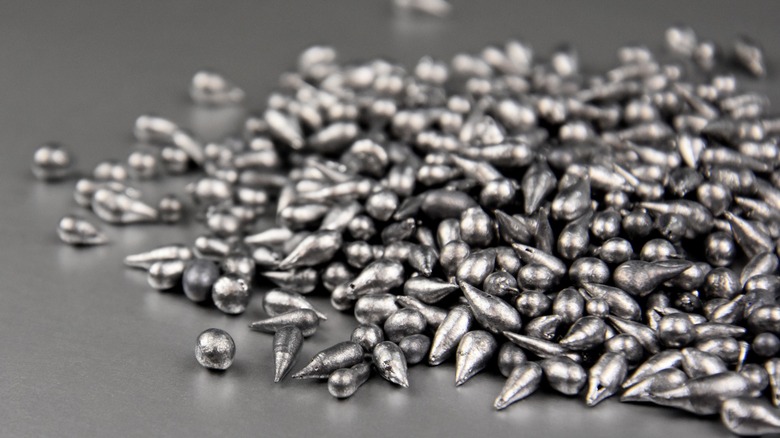Stanley Vs HydroJug: What's The Difference Between These Popular Tumblers?
We may receive a commission on purchases made from links.
People like to talk about the online bubbles we're all siloed into, but if you're on social media, you've almost certainly witnessed the reusable water bottle craze that has taken the internet by storm in recent months. Stanley appeared to be the clear winner, as the company's colorful pastel bottles were seen as the apex of a healthy and hydrated lifestyle, complete with TikTok dances and hundreds of home reviews. But the fickle tides of fate may be receding, pulling Stanley back into the mix of market competition.
The most recent competitor to mark its territory is HydroJug (not to be confused with the other reusable bottle brand, Hydro Flask). HydroJug has been flying under the radar for some time now. It didn't even register on our list of the 15 most popular water bottles, which came out in August 2023. But if you browse through TikTok even for a moment, you'll find dozens of videos showing Stanley fans ditching their old Stanley cups in favor of a HydroJug.
It's important to drink enough water every day, and a reusable water bottle is a great way to make that happen. But it's good to know what you're buying before you place the order. We're going to focus on the two most popular products from both companies, the Stanley Quencher and the similar looking HydroJug Traveler, but both brands have an extensive catalog of products to choose from, so feel free to dig deeper if these tumblers aren't exactly what you're looking for.
What are Stanley tumblers?
Although Stanley has been able to capitalize on the renewed interest in proper hydration, the company is far from an overnight grift looking to cash in on social media trends. Stanley was founded over 100 years ago in 1913, when William Stanley Jr. invented the very first Stanley product: an all-steel vacuum bottle. His design used vacuum insulation to keep the contents of the cup hot or cold, while remaining durable through its use of steel. A great many modern reusable water bottles still use this exact design today, and the popular Stanley Quencher is one of them.
Of course, the design of Stanley products has changed quite a bit over the years. Originally marketed toward blue collar workers in need of a sturdy way to stay hydrated on the job, the new Stanley Quencher comes in a kaleidoscope of cute and colorful pastels, all of which are going gangbusters with self-described "Stanley cup girlies" who are part of the it girl Stanley tumbler trend. It's nice to see a company with broad appeal, but the increase in revenue that has come out of its newly discovered market audience is honestly jaw dropping.
In 2019, Stanley posted a revenue of around $70 million. Although the official data hasn't been released yet, the expected numbers for 2023, according to Statista, are close to an eye-popping $750 million – that's an over 1,000% increase in revenue in just four years. Although Stanley is not alone, it's safe to say that the company discovered an untapped market through the Quencher and forever changed the industry because of it.
What are HydroJug tumblers?
HydroJug is a more recent contender in the industry, having only arrived on the scene in 2016. The company was founded by the brothers Hayden and Jake Wadsworth in Ogden, Utah, and every year the brand seems to get more popular. Although the company has likely faced stiff competition and challenging obstacles along the way, 2024 is a make-or-break year for this company, as the brand is really stepping out onto the national (if not global) stage for the first time. Like most successful companies in this market, HydroJug focuses on producing high-quality drinkware products using safe and healthy materials.
We'll get more into how the materials differ from Stanley here in just a second, but it's worth considering just how much the market has shifted toward premium goods. A deep dive into this phenomenon would require a separate article, but the shift arguably started in 2014 when YETI began making its uniquely durable (and expensive) drinkware and coolers. In many ways, the success of YETI paved the way for Stanley's transition to the Quencher and for HydroJug's ascension just behind it. But enough about the companies themselves, let's look at the products.
The HydroJug uses slightly different materials
First off, the Stanley Quencher comes in five different sizes ranging from 14 ounces to 64 ounces. The HydroJug Traveler, meanwhile, is sold in three sizes: 20, 32, and 40 ounces. Both products use BPA-free stainless steel and vacuum insulation to create a container that can keep your ice frozen and your coffee hot for hours at a time. The HydroJug does differentiate itself by using a triple-layer insulation as opposed to Stanley's double-wall insulation, which theoretically would improve its temperature retention.
We say theoretically, because we couldn't find good info on just how long the HydroJug keeps things hot or cold. A Stanley cup will keep cold drinks cold for 11 hours and hot drinks hot for seven hours with its double insulation. HydroJug claims it can keep contents hot or cold for 24 hours. But customer feedback for HydroJug has been mixed on temperature retention, so take it with a grain of salt.
One of the first things HydroJug owners will notice is the rubber base at the bottom of their Traveler cup, which eliminates the annoying metallic clang that you get when you set a Stanley cup down. The HydroJug isn't exactly silent, but it's significantly more muted by comparison. Both the Stanley and HydroJug tumblers use a powder coat finish to achieve that sleek, smooth look that everyone loves. Some online chatter would suggest that the HydroJug's coating is less likely to chip than that of a Stanley, but it's probably too soon to say for certain.
HydroJugs are virtually spill-proof, but Stanley can't say the same
When it comes to reusable water bottles, the lid is arguably the most important part of the design. At face value, HydroJug's lid appears to have a considerable advantage over the Stanley lid because it is virtually spill-proof, so long as it's closed up tight. One of the main complaints customers have about Stanley cups is that they leak their contents the moment they turns sideways. That's not the case for HydroJugs. You can hold a HydroJug upside down and shake it and absolutely nothing will come out, which is a big selling point for anyone with kids. There is a downside to this, but we'll get back to that in a moment.
Stanley cups use a lid that has a rotating cap on it that covers the drink spout. Its innovative design allows for three different modes. You can close it, you can uncover it to drink directly from the spout, or you can use the straw hole to place a straw inside and drink that way. So, while it does leak if tipped over, it is a versatile lid that lots of people love. HydroJug has a circular straw built into its lid, which you can easily pop open or closed – just make sure the straw is fully closed to keep it spill-proof. A longer, detachable straw fits into the bottom of the lid, so you can sip away even when the cup gets low.
Cleaning a Stanley is much easier than a HydroJug
So far, HydroJug has been looking pretty good in comparison to Stanley. But it's important to clean reusable water bottles regularly. Both Stanley and HydroJug tumblers are dishwasher safe, which is convenient, but there's still a problem. You see, HydroJug's collapsible straw lid is completely spill-proof and easy to use, but it doesn't come apart. That makes it fairly difficult to clean, and many customers have reported mold growth around the edges of the straw that are out of reach of household cleaning equipment.
The HydroJug website recommends regularly soaking the lid in a mixture of dish soap, vinegar, and water to keep mold from forming, but the company doesn't specify exactly how often customers should take this step. Constantly having to soak your water bottle on top of regular cleaning isn't exactly convenient, and drinking water that's filtering through active mold isn't winning over new customers, either.
If HydroJug doesn't find a better solution quickly (such as a lid with a detachable straw), the company may find its 15 minutes of fame coming to an abrupt end once the brand is associated with this issue. Stanley's lid does have leaking issues like we addressed. But all of the pieces are detachable, which makes for a much more convenient and thorough cleaning process, so long as you properly dry them. Cleaning Stanley cups isn't perfect, though, as some customers complain about the color coating chipping off even when they are washed by hand.
Both tumblers likely contain lead in the base
If you've been following the Stanley fad at all, you're likely aware that the first major hiccup in the brand's image was when the company admitted that its tumblers contained lead in early 2024. Before you call your doctor about lead poisoning, keep in mind that only a small amount of lead is used in the base of the product, and it's tucked away from all internal or external surfaces. In other words, unless you break the bottle apart, the lead will never touch your hands or the cup's liquid contents.
But there's a reason society takes lead poisoning as seriously as it does. Lead poisoning can be fatal at a high enough dose, and even low doses can cause premature birth or miscarriage in pregnant women, developmental complications in children, and cognitive decline in adults, among other unpleasant symptoms. Lead can accumulate in your body over a long period of time, so even a small amount is a reasonable cause for concern.
Stanley has maintained that its products are completely safe despite the presence of lead in the base, but the news has many of us searching for water bottles that contain no lead whatsoever. HydroJug, unfortunately, cannot be named among them. To be clear, the company hasn't publicly stated whether HydroJug products contain lead or not. But at a time when the presence of lead is currently crippling the top brand's image, one would assume that HydroJug would be dying for an opportunity to distance itself from such accusations — and this has yet to happen.
